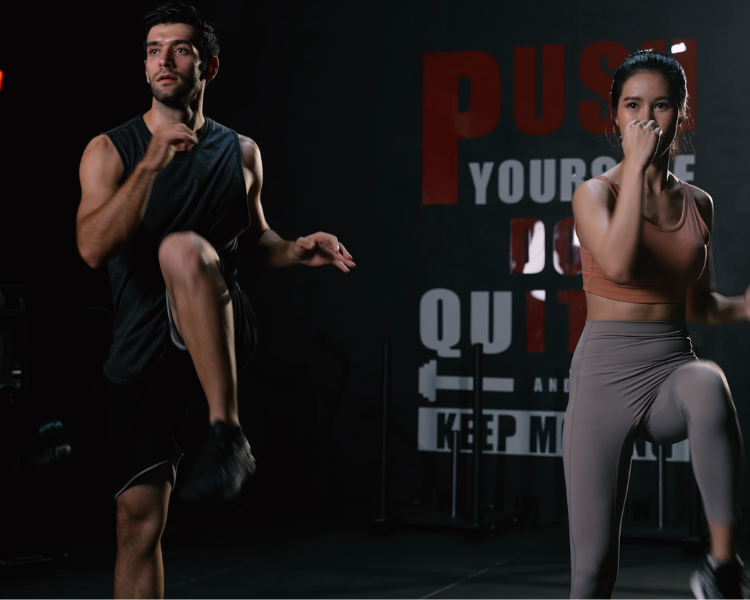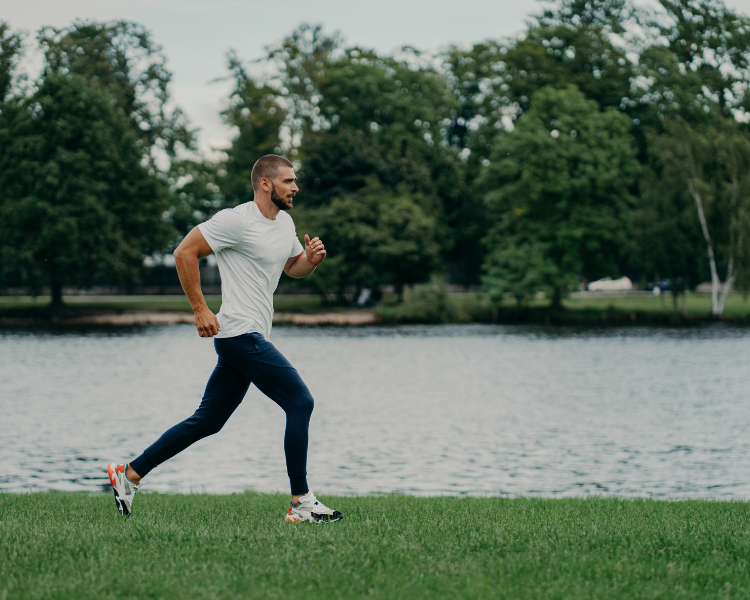There are plenty of tools and pieces of equipment you can use on your fitness journey. Exercise bands are a helpful fitness tool that can allow any level of athlete to do a range of stretches and movements. Resistance band stretches are a great way to work out your full body and we'll show you exactly how you can do that in this article.
11 great resistance band stretches for a full-body routine at home
There are plenty of tools and pieces of equipment you can use on your fitness journey. Exercise bands are a helpful fitness tool that can allow any level of athlete to do a range of stretches and movements. Resistance band stretches are a great way to work out your full body, and there are various different stretches you can choose from. You can create an entire resistance band routine with the following common 11 stretches.
Warming Up
Warming up is vital for any workout you want to perform, including resistance band stretching. Even though these exercises are already stretches, you should still do some basic warm-up stretches to get your muscles ready. This can prevent a lot of injuries and will get your blood pumping and heart rate up. Warming up should be your first step in any fitness routine.
Resistance Band Stretches
These 11 stretches with exercise bands can be used to create a routine to work out your entire body. Resistance band stretches can be great for your glutes, arms, back, and neck muscles.
Inner Thigh Stretch
The inner thigh stretch is a great movement to use a resistance band for, and it is even easy for beginners to get the hang of.
- Start by lying on your back on the floor, with the band looped around one foot.
- Grab the band with the hand on the same side of the foot that it is looped around. You can also grab both sides of the band with both hands to make it easier.
- Gently lower your leg out, and to the side, careful not to move too fast. Do this until you can feel the stretch in your inner thigh.
- Hold for between 15 and 30 seconds.
- Switch feet and stretch the other thigh the same way.
Hamstring Stretch
The hamstring stretch performed with a resistance band is a similar movement to the inner thigh stretch. It starts out the same and stretches many of the same muscles.
- Start on your back on the floor, the band looped around one foot.
- Grab the band and straighten your leg as much as possible. Make sure you can feel the stretch but don’t push too hard.
- When straightening your leg, keep the opposite one bent by having your foot flat on the ground.
- Once your leg is as straight as possible, pull it towards you. Hold this position for 15 to 30 seconds.
- Repeat with your other leg.
Chest Stretch
Resistance bands are great for performing chest stretches. However, these stretches are not recommended for people with shoulder injuries or issues.
- To start the chest stretch, sit cross-legged on the floor, or in a chair with feet flat on the ground.
- Hold your hands a few inches apart, gripping the band.
- Pull your arms down and out, gently, to stretch your chest muscles.
- You can adjust where your hands are grilling to add more or less tension to the band. Be sure not to have the band too tight or too loose.
- You should feel the stretch in your chest comfortably.
Upper Back Stretch
The upper back can be stretched using a resistance band, and this is actually one of the most helpful back stretches to do. Just be sure to stop if the movement causes any pain.
- Start the upper back stretch by sitting on the ground with your legs extended straight out.
- Loop the band around both your feet, cross the band, and then hold onto it with both hands relatively close to your feet.
- Gently curl your back, creating tension in the bands, and hold it for 15 to 30 seconds.
- When doing this stretch your abs should contract, and you should feel your shoulder blades spread apart.
Lying Hip Stretch
The lying hip stretch has been found to help relieve back pain and can be easily performed using a resistance band. The key to this movement is making sure your body stays parallel to the ceiling.
- Lie on your back on the floor, looping the band around one foot.
- Use your opposite hand to grab the resistance band, and keep your other leg straight out on the floor.
- Lower your leg across your body to create tension in the band. Lower until you feel the stretch in your glute and hip.
- Hold the position for 15 to 30 seconds.
- Repeat with your other leg.
Kneeling Quad Stretch
A more challenging resistance band stretch that you can try out is the kneeling quad stretch. This can give your glutes a deeper stretch than other resistance band exercises.
- Sit down with your right leg bent in front of you, and your left leg bent behind you.
- Loop the resistance band around one of your feet, then lean to the opposite side, using the band to pull your heels toward your glutes.
- Hold this for 15 to 30 seconds, and then repeat with your other foot.
- You should stretch gently and slowly, stopping if you feel any kind of pain.
Side Stretch
The side stretch performed with a resistance band can help you increase your flexibility over time. If you do this stretch too deeply it could hurt, so make sure to move slowly and gently.
- Either sit in a chair or sit cross-legged on the floor.
- With one hand hold one end of the band and stretch your other arm out straight to the side.
- Grab the other end of the band with your other hand, and pull to create tension.
- Hold this for 15 to 30 seconds. Repeat it on your other side.
- Do this movement slowly and gently to avoid any pain or discomfort.
Calf Stretch
The calf stretch is one of the easiest resistance band stretches to perform and is beginner friendly. This should be included in every resistance band routine.
- Sit on the floor with your legs straight out in front of you, toes pointed toward the ceiling.
- Wrap the band around the bottom of one of your feet, holding each end of the band with your hands.
- Pull the band toward you to flex your foot.
- Hold this for between 15 and 30 seconds.
- Switch and perform with your other foot.
- Make sure the band is not too loose or too tight when doing this stretch.
Forearm Stretch
Resistance bands can also be great for stretching out your arm muscles, especially with the forearm stretch. This movement can help you round out your routine. This stretch needs to be repeated three times.
- Stand up with one arm extended away. Make sure your palm is facing away from you.
- Loop the band around your hand, using the opposite hand to hold the ends of the band.
- Flex your fingers while pulling the band away from your outstretched arm, creating tension.
- Hold this for ten seconds and do the movement two more times.
- Switch hands and do the other arm for three separate movements.
Neck Stretch
Resistance bands can be extremely helpful in stretching your neck, and the neck stretch should be somewhere on every resistance band routine. Just like the forearm stretch, the neck stretch needs to be repeated three times.
- Grab onto the band with both hands, laying the middle of the band across the back of your head.
- Tuck your chin gently, making sure you don’t feel any pain.
- Pull both sides of the band down to intensify the stretch.
- Hold this for 10 seconds, and then do it two more times.
- The resistance band neck stretch should be repeated a total of three times.
Front Raise Stretch
One of the most common resistance band stretches is the front raise stretch. This movement will stretch your arms and abs at the same time.
- Start by standing in the middle of the band, with your feet shoulder-width apart.
- Hold onto each end of the band, keeping your back straight, and raise your arms up.
- Raise your arms as much as you can, making sure to feel the stretch.
Cooling Off
Cooling off is just as important as warming up when it comes to performing resistance band stretches, or any other kind of exercise. Make sure to do a few cool off stretches, and take rests between movements if you need to. You should also drink plenty of water before, during, and after your routine. Cooling off and warming up should both take around 10 to 15 minutes.
What To Keep In Mind
There are a few tips to keep in mind when going through resistance band movements. These tips will keep you safe and make sure you are performing the exercises correctly.
Tips to keep in mind include;
- Always do warm up and cool down stretches and movements.
- Make sure to stay hydrated.
- If you feel any pain or discomfort when performing a movement then stop immediately.
- Always do resistance band stretches slowly and gently.
In Conclusion
You can find numerous resistance band stretches to create a full-body routine. These movements can be helpful for all levels of athletes, as long as you make sure to warm up, cool down, and perform each movement with good form.
--
Want to up your Health & Fitness? Check out these articles:
- How long should my workout be? Find out here
- How to hire a personal trainer to reach your goals
- Just starting your fitness journey? Here's 4 things to keep in mind
About the Author:
Cory McKane
Cory is a huge fan of fitness - and an even bigger fan of helping you with your fitness. He's started on his journey with WeStrive back in 2015 and has been building it ever since.

.png)






